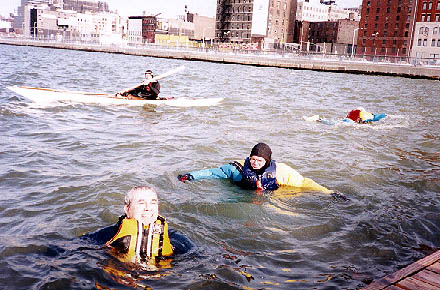

1. Thermally
neutral water - 9FF (330C) — heat production balances heat loss
2. Hypothermia — water temperature <910F, significant hypothermia
if T < 770F
3. Risk of hypothermia — universal year round in the N. America
4. Problems in cold-water immersion — hypothermia and near-drowning
Hypothermia — lowering of the body core temperature below the normal level (98.60F), at which normal body functions are impaired.
Recreational activities, including kayaking — major source of immersion accidents. Hypothermia claims much more lives than drowning.
Effects of hypothermia on bodily functions
1. Respiratory
system
- initial reflex gasp, followed by fast and deep breathing (hyperventilation)
— 5’
- implications — aspiration of water, drowning, confusion, muscle
tetany
- significant reduction of under-water breath-holding times — decreased
survival
- slowing and eventually stopping of breathing
2. Cardio-vascular system — release of adrenaline
- peripheral
vasoconstriction — blood flow to skin and muscles, core
insulation
- increase in heart rate and blood pressure — first few minutes
- irregular heart beat — extrasystole, ventricular fibrillation, sudden
cardiac
death (remember, the lower the body temperature, the more likely the
arrhythmias
and especially sensitivity of the heart muscle to mechanical stimulation)
- increased urine production — up to 350%, risk of hypovolemia,
dehydration
- slowing and eventually stopping of the heart
 Central
nervous system
Central
nervous system
Tolerance to low oxygen levels and metabolic demands of the body
- progressive
depression of mental statu
- moderate hypothermia — hallucinations, impaired judgment, disorganized
mental activity — panic, fear, loss of will to live
- loss of consciousness at core T < 80-860F (27-300C)
4. Musculo
— skeletal system
- decreased blood supply to limbs, declining temperature of limbs
- impaired muscle performance - - limb strength, coordination, response
time
- inability to swim, stay afloat, pull out of the water, use of signaling
devices
Metabolic heat production
After 15 minutes
- decline of skin and core temperature.
Skin T<910 F (330 C) shivering - major mechanism
of heat production
Heat loss and cooling rate in cold water.